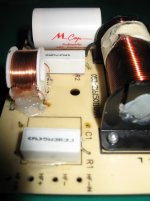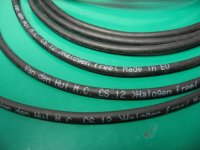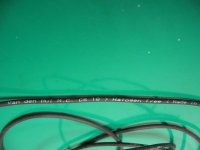I wonder what they would sound like with the tweeter polarity reversed, to improve the xover dip ?
Why would you want to do that? Gornir's measurements show decent enough phase tracking with the over as is. If you invert the tweeter you'll just get a nice deep null.
Edit - apologies you were referring to the active version.
Last edited:
The right way to go. You can't match the performance of an active crossover with a passive one. I saw the improvement you made. How would you describe the difference in sound?
I want clarify my comment on the damping material. The cutaway picture shows the proper way that it was done. It does not need to be glued down, but it needs to be lined up against the cabinet walls. In a vented box design, volume stuffing the cabinet has very little benefit.
Volume filling a reflex box
I will try to get inside again an align the material on the walls and see if that changes the sound.
The speakers seem better controlled by the amp, the sound seems more coherent and authoritative, and I could adjust the phase to be perfect in sync on both the tweeter and woofer. Couldn't notice any xover dip while taking measurements later.
Hope I have some time to do two sets of measurements, one with the passive xover (ran into it in the junk bin last night) and one with the active xover. I could clearly see the dip at xover point with passive. With active I can't tell from the graph.
Next step will be a digital EQ. I just did it for my fullrange BLH speakers and it worked wonders!
I'm now busy with managing a decent wi-fi system so I can play wirelessly to my main BLH speakers.
Just need to iron out some random pops and I'm all good, maybe I can make the measurements with the Wharfedale.
my upgrade wharfedale 10.1
Attachments
Why would you want to do that? Gornir's measurements show decent enough phase tracking with the over as is. If you invert the tweeter you'll just get a nice deep null.
Edit - apologies you were referring to the active version.
I think the picture in post 9. as far as I can tell this was the passive version... certainly looks like the tweeter needs inverting 🙂
Tony.
I think the picture in post 9. as far as I can tell this was the passive version... certainly looks like the tweeter needs inverting 🙂
Tony.
They don't match Gornir's measurements at all.
Ha, I forgot I actually posted the measurements.
I think the first picture is with passive xover and the second is with active.
I think the first picture is with passive xover and the second is with active.
They don't match Gornir's measurements at all.
If I'm not mistaken, gornir measured a 10.2 set, I have 10.1, smaller.
Also my measuring mic is not calibrated (but I'm interested in the general idea, not something very precise).
So I wouldn't call my work a reference, just more of a general idea of what's happening.
Also my passive had a different xover point than 10.2, but I can't remember for sure. Different part values.
Measuring with uncalibrated mic would mostly corrupt the output you read above 5Khz and below 300Hz, otherwise even uncalibrated they`re pretty flat.
Measuring with uncalibrated mic would mostly corrupt the output you read above 5Khz and below 300Hz, otherwise even uncalibrated they`re pretty flat.
Can the difference be that high? I always thought that it's 2-3dB at most. Calibrated for me meant ultra precision measurements.
If the offset is too large then I might consider selling this one and getting a UMIK-1 mic. The service alone would cost too much to calibrate it, not considering two way shipping.
So far I've done EQ on my BLH enclosure and the result was great, using this microphone. But if I can do it even more precise, I might consider swapping it.
If you want to send it over the southern border, I can run a reference curve to my calibrated MM1 and send it back to you with the new curve parameters, then you can create your own calibration file.
But my point was exactly the opposite - you don`t need the lower spectrum for home diy measurements, to obtain an accurate reading speaker needs to be in a very large space with no walls, neither floors near it ( best achievable is lifted 3m+ in air in a big empty storage house ). And above 5Khz, at least based on the data I saw for ECM8000 from the chaps that calibrated the Beyer, deviations can be quite large but thing is, while peaks and dips in the 5-8Khz area are easily audible, you could trust the manufacturer published graph for the tweeter and assume it does somewhere around it, for as long as you don`t use some exotic implementation relative to the baffle. Often a phase tracking mismatch would create a dip in the response in the 5-7Khz area but if you do your crossover well, it should be flat enough.
But my point was exactly the opposite - you don`t need the lower spectrum for home diy measurements, to obtain an accurate reading speaker needs to be in a very large space with no walls, neither floors near it ( best achievable is lifted 3m+ in air in a big empty storage house ). And above 5Khz, at least based on the data I saw for ECM8000 from the chaps that calibrated the Beyer, deviations can be quite large but thing is, while peaks and dips in the 5-8Khz area are easily audible, you could trust the manufacturer published graph for the tweeter and assume it does somewhere around it, for as long as you don`t use some exotic implementation relative to the baffle. Often a phase tracking mismatch would create a dip in the response in the 5-7Khz area but if you do your crossover well, it should be flat enough.
Last edited:
I really appreciate the offer and I might take you up on it ! 🙂
The thing is that I used this mic to EQ my BLH speakers, and I might make another set of smaller BLH or even bookshelf and I would like to have a calibrated mic.
I only worked on the low end on my BLH, from 40 to 120Hz or so. I ended doing the EQ manually but still relied on the output from the microphone.
Also I might consider adding a sub to the system and also try and solve some room problems and add material to corners etc. I do have some nasty resonances in the 50-80Hz area.
The thing is that I used this mic to EQ my BLH speakers, and I might make another set of smaller BLH or even bookshelf and I would like to have a calibrated mic.
I only worked on the low end on my BLH, from 40 to 120Hz or so. I ended doing the EQ manually but still relied on the output from the microphone.
Also I might consider adding a sub to the system and also try and solve some room problems and add material to corners etc. I do have some nasty resonances in the 50-80Hz area.
I use the Wharfedale Pro 8.2 active bi-amped speakers.
I sort of wish i could get an updated version of this speaker like any of the newer diamond series that was active and bi-amped or maybe even one of their higher end models like the Jade M-1 with the Giant Dome mid driver. But i doubt that they cleaned up the design all that much beyond some really anal measurements.
IAG / Wharfedale makes all of their own components in house and my hunch is that it would be hard to outdo their passive crossovers. But making them active i think these sort of designs just perform better as the mid driver can run out of steam a lot faster than the tweeter and can cause intermodulation distortions.
Also i don't think traditional bass reflex rules apply to these speakers. If you look at the ports they have a net on them which makes them a-periodic. I am no speaker expert but i don't think there is a lot known about hybrid designs like this on the internet.
I sort of wish i could get an updated version of this speaker like any of the newer diamond series that was active and bi-amped or maybe even one of their higher end models like the Jade M-1 with the Giant Dome mid driver. But i doubt that they cleaned up the design all that much beyond some really anal measurements.
IAG / Wharfedale makes all of their own components in house and my hunch is that it would be hard to outdo their passive crossovers. But making them active i think these sort of designs just perform better as the mid driver can run out of steam a lot faster than the tweeter and can cause intermodulation distortions.
Also i don't think traditional bass reflex rules apply to these speakers. If you look at the ports they have a net on them which makes them a-periodic. I am no speaker expert but i don't think there is a lot known about hybrid designs like this on the internet.
Last edited:
The net could just be there to stop small animals from getting inside.😀
😛 I've just seen a measurement where it cleans up the overhang to a negligible level. Not sure what it would do to throw off normal bass reflex modeling though.
The net does not make them aperiodic in any way 🙂 Its usually added to prevent small children from putting toys into your loudspeaker. Or maybe rats that want to replenish their body electrolytes with the wrong type 😀
Hi All,
I just picked up a pair of demo spks and was wondering if they made a change? The features description on the Music Direct web site said "Polypropylene Capacitors on tweeter crossover for silky smooth highs". After reading the posts here, I called them and asked if they did in fact have polypro and the salesman said he did not know for sure, but this is what Wharfedale supplied to them. I do plan to change to better caps, but wanted to ask all of you that have looked inside, what you found.
Also has anyone come up with a higher order x-o or improvements to the current design?
I just picked up a pair of demo spks and was wondering if they made a change? The features description on the Music Direct web site said "Polypropylene Capacitors on tweeter crossover for silky smooth highs". After reading the posts here, I called them and asked if they did in fact have polypro and the salesman said he did not know for sure, but this is what Wharfedale supplied to them. I do plan to change to better caps, but wanted to ask all of you that have looked inside, what you found.
Also has anyone come up with a higher order x-o or improvements to the current design?
I think that I was the one who originally recommended the Mundorf MKP's as being a very good affordable upgrade, so I would love some feedback on any auditory experiences, and subjective changes by swapping out the caps.
Best,
Erik
Best,
Erik
- Status
- Not open for further replies.
- Home
- Loudspeakers
- Multi-Way
- Inside the Wharfedale Diamond 10.1




